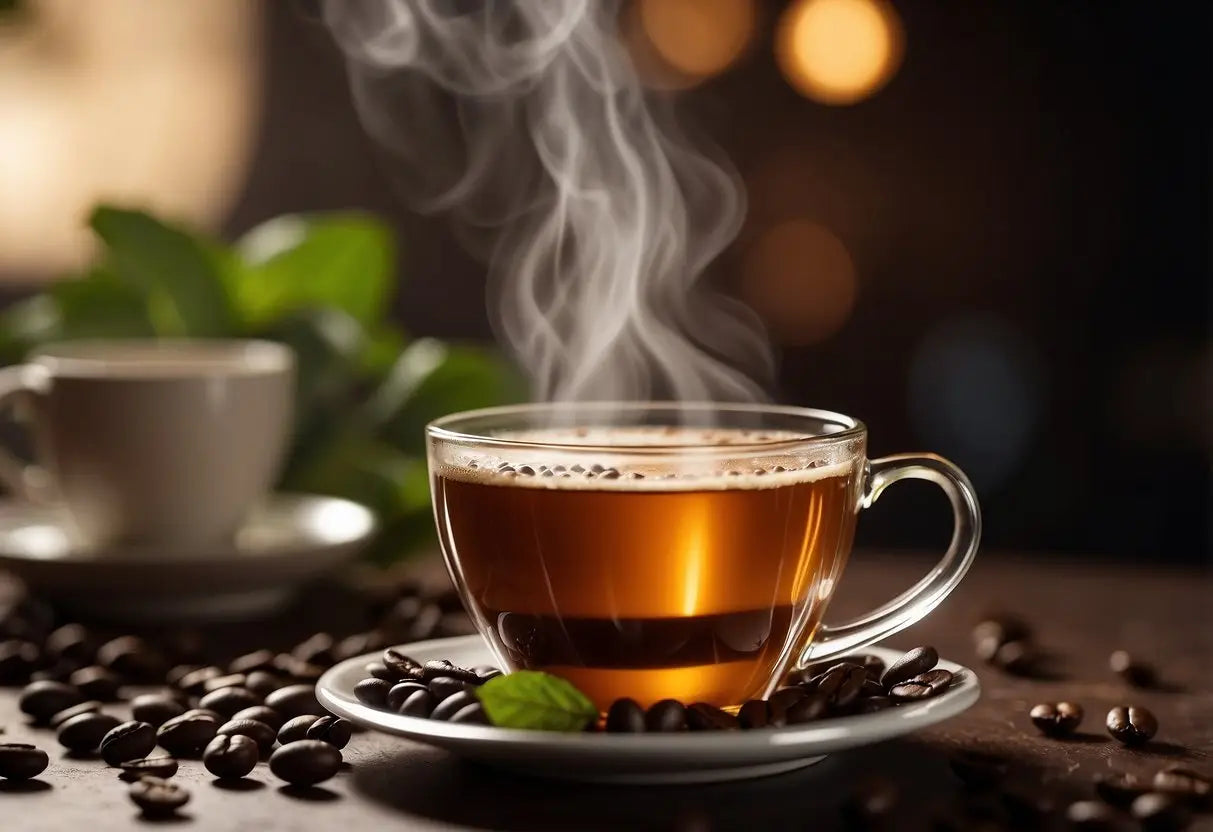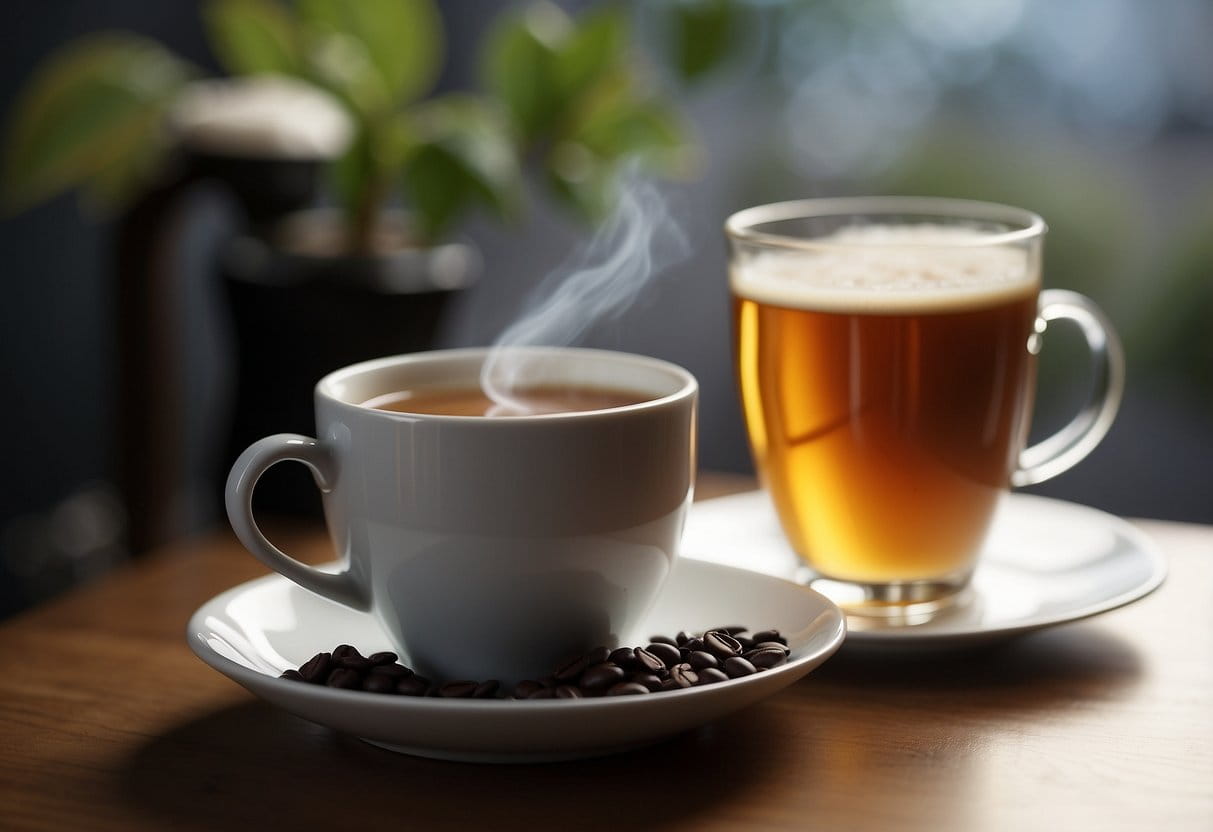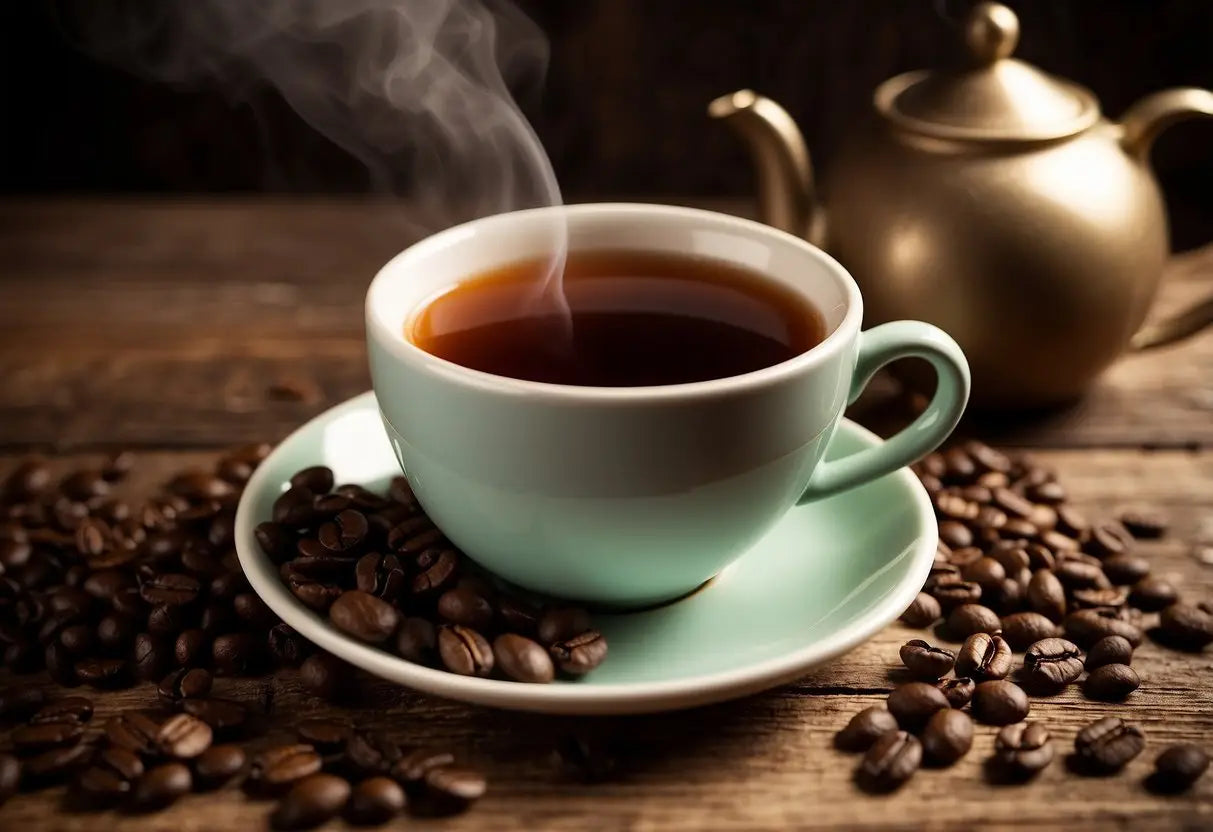Tea That Tastes Like Coffee
Flavor Notes
Tea:
- Green Tea: Grassy, fresh, sometimes sweet.
- Black Tea: Bold, malty, sometimes bitter.
Coffee:
Bestsellers
- Arabica: Smooth, acidic, more nuanced.
- Robusta: Strong, bitter, earthy.
Aroma
- Tea often has floral, fruity, or spicy aromas.
- Coffee can smell of chocolate, nuts, or caramel.
Caffeine Content
- Tea: Generally lower caffeine levels.
- Coffee: Higher caffeine content.
Brew Time
- Tea: 2-5 minutes.
- Coffee: 4-5 minutes (drip), 20-30 seconds (espresso).
Texture
- Tea: Light, sometimes creamy.
- Coffee: Thicker, sometimes oily.
Color
- Tea: Ranges from pale green to dark amber.
- Coffee: Dark brown to black.
Common Additives
- Tea: Lemon, honey, milk.
- Coffee: Sugar, milk, cream.
Regional Preferences
- Tea: Popular in Asia, UK.
- Coffee: Favored in the Americas, Europe.
Pairings
- Tea: Biscuits, light snacks.
- Coffee: Pastries, chocolate desserts.
Exploring Coffee-Flavored Tea Varieties

Coffee-flavored teas provide a unique blend of tea and coffee experiences. They cater to those who enjoy the robustness of coffee but prefer the lighter characteristics of tea.
Black Tea Blends
Black tea blends combined with natural coffee flavors offer a rich, bold taste. You can find varieties where black tea leaves are infused with coffee beans or flavors. These blends typically have a robust body, resembling traditional coffee tones while retaining the slight astringency and tannins typical of black tea.
Some popular options include Earl Grey Coffee and Mocha Java Black Tea. These blends can be enjoyed both hot and iced, suiting different preferences. They often contain a moderate level of caffeine, bridging the gap between tea and coffee drinkers.
Herbal Infusions
Herbal infusions mimic coffee flavors without caffeine, perfect for those seeking a coffee taste without the stimulating effect. Ingredients like chicory root, roasted barley, and carob pods are common. Their roasted, earthy notes contribute to a rich, coffee-like experience.
Roasted Dandelion Root Tea and Barley Tea are frequently chosen options. These herbal teas are versatile and can be enjoyed in various brewing methods. They offer a comforting, warm beverage with zero caffeine content, appealing to those wanting a decaffeinated alternative.
Brewing Techniques for Coffee-Like Tea
To achieve a tea that emulates the robust flavors of coffee, precise brewing methods are essential. Key factors include selecting the right tea blend and adjusting steeping times and temperatures.
Steeping Methods
For a rich, coffee-like tea, steep the tea for 8-10 minutes. This extended steeping time extracts deeper flavors.
Water Temperature: Use boiling water (around 212°F or 100°C). High temperatures help release complex flavors.
Tea-to-Water Ratio: Opt for 1 teaspoon of tea per 6 ounces of water. Adjust for stronger flavor if needed.
Filter Type: Use a fine mesh strainer or French press to avoid sediment.
Experiment with these variables to find your preferred balance of strength and flavor.
Lao Ban Zhang
Health Benefits and Considerations
Tea that tastes like coffee offers unique health benefits and considerations. It provides a lower caffeine content than traditional coffee and contains various antioxidants that may benefit your health.
Caffeine Content
Tea that mimics coffee typically has less caffeine than regular coffee. While a standard cup of coffee might have around 95 mg of caffeine, tea options often contain less than half that amount. This makes it suitable for sensitive individuals who want to reduce their caffeine intake without sacrificing the rich flavors they enjoy.
Lower caffeine levels can lead to reduced anxiety and better sleep. You can enjoy the taste of coffee without the jittery side effects. It's also advantageous for heart health, as excessive caffeine can cause heart palpitations or increase blood pressure.
Antioxidants and Compounds
This tea contains powerful antioxidants like polyphenols and flavonoids. These compounds help combat free radicals in your body, potentially reducing the risk of chronic illnesses such as heart disease and certain cancers.
Additionally, these teas often include compounds like L-theanine, which can promote relaxation and improve focus. The combination of lower caffeine and beneficial compounds provides a more balanced, healthier beverage option. In some cases, they also contain essential minerals and vitamins, further contributing to your well-being.
Consumer Preferences and Trends

Consumers are showing an increasing interest in tea that tastes like coffee. This trend seems to be driven by a desire for variety and health-conscious choices.
Key factors influencing these preferences include:
- Health Benefits: Many people want to reduce their caffeine intake. Tea offers a lower-caffeine alternative with similar flavors.
- Environmental Concerns: Ethical sourcing of ingredients is a significant factor. Eco-friendly consumers look for sustainable options.
- Flavor Innovation: Unique blends attract adventurous drinkers who seek new taste experiences.
Top Features Consumers Look For:
- Authentic Coffee Flavor: The tea must closely mimic coffee's rich, bold profile.
- Convenience: Easy-to-brew options like teabags or instant mixes are preferred.
- Natural Ingredients: There's a strong preference for natural and organic ingredients.
Here's a table detailing some consumer preferences:
| Preference | Description |
|---|---|
| Lower Caffeine | Opting for reduced caffeine content |
| Ethical Sourcing | Preference for sustainably sourced tea |
| Unique Blends | Interest in innovative flavor profiles |
| Convenience | Favoring easy preparation methods |
The growing trend of tea that tastes like coffee highlights a shift in consumer habits. Whether for health reasons, ethical concerns, or simply the love of new flavors, this trend is capturing attention.
Comparative Analysis of Taste Profiles

When comparing tea that tastes like coffee with regular coffee and traditional tea, several characteristics come to light.
First, aroma is a significant factor. Coffee typically has a robust, earthy scent, while traditional tea varies from floral to grassy. Tea that mimics coffee often incorporates roasted herbs and grains to capture that coffee-like aroma.
Flavor is another aspect to consider. Coffee is known for its strong, sometimes bitter taste, while tea can range from sweet to mildly astringent. Tea that tastes like coffee usually features a blend that balances bitterness with a smoother finish.
Additionally, mouthfeel plays a role. Coffee generally has a full-bodied, rich texture. In contrast, tea is lighter and more refreshing. To replicate coffee's mouthfeel, tea may use ingredients like chicory or roasted barley, adding depth and complexity.
In terms of caffeine content, coffee is typically more stimulating due to higher levels of caffeine. Traditional tea ranges in caffeine levels, depending on the type. Tea that tastes like coffee can vary; some blends aim to match coffee's caffeine kick, while others offer a milder alternative.
Here’s a comparison table for quick reference:
| Characteristic | Coffee | Traditional Tea | Tea That Tastes Like Coffee |
|---|---|---|---|
| Aroma | Earthy, robust | Floral, grassy | Roasted, earthy |
| Flavor | Strong, bitter | Sweet, astringent | Balanced bitter and smooth |
| Mouthfeel | Full-bodied | Light, refreshing | Rich, deep |
| Caffeine | High | Varies | Varies |
By understanding these different profiles, you can better appreciate the unique attributes of tea that emulates coffee.
Culinary Uses of Coffee-Flavored Tea

Coffee-flavored tea adds a unique twist to traditional recipes. You can use it as a base for interesting beverages and creative dishes.
Beverages
- Iced Coffee-Tea: Brew and chill coffee-flavored tea. Serve over ice with milk and sugar.
- Smoothies: Blend cooled coffee-flavored tea with banana, yogurt, and a touch of cocoa.
Desserts
Coffee-flavored tea can enhance desserts beautifully.
- Tea-Infused Cake: Replace water or milk in cake recipes with strong coffee-flavored tea.
- Ice Cream: Use it to infuse the base of homemade ice cream for a subtle coffee flavor.
| Dessert | How to Use |
|---|---|
| Cookies | Substitute water with coffee-flavored tea in dough. |
| Pudding | Replace part of the milk with brewed tea. |
Savory Dishes
You can also use this tea in unexpected ways in savory dishes.
- Marinades: Brew a pot and use it as a marinade base for meats.
- Sauces: Infuse the tea into cream or tomato sauces for a rich, nuanced flavor.
Marketing Coffee-Tasting Tea Products

Creating effective marketing strategies for coffee-tasting tea products involves targeting both coffee and tea drinkers. Highlight the unique flavor profile. Emphasize the convenience and benefits, especially for those reducing coffee intake.
Key Features to Promote:
- Rich, Coffee-Like Flavor
- Lower Caffeine Content
- Health Benefits
Use social media platforms to engage potential customers. Share testimonials, brewing tips, and recipes to foster a community.
Potential Marketing Channels:
| Channel | Strategy |
|---|---|
| Social Media | Share user-generated content, host live brewing sessions |
| Email Marketing | Send informative newsletters, exclusive discounts |
| Retail Partners | Collaborate with tea shops, coffee houses, and health stores |
| Influencer Marketing | Partner with food bloggers and wellness influencers |
Target Demographics:
- Coffee lovers looking for alternatives
- Health-conscious consumers
- Enthusiasts seeking new flavors
Highlight the sustainable and ethical sourcing of ingredients. This can appeal to environmentally conscious buyers. Use bold and italic text sparingly for emphasis.
Promotional events such as taste-testing in local cafes or virtual tasting parties can also be beneficial. Always keep the messaging clear and consistent to establish trust and recognition.
← Older post Newer post →











